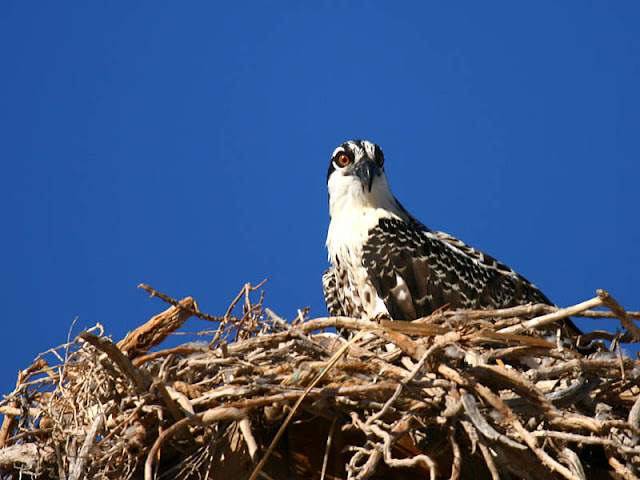I wrote a birding site guide to Crown Point Park in January 2014. You might want to view that, too.
 |
| Crown Point Park |
 |
| Brant. Chula Vista, California. January 30, 2016. Greg Gillson. |
About 750-1500 of these small marine geese wintered in Mission Bay and San Diego Bay at the end of the 20th century (Unitt 2004). To my eye, there are at least that many birds now. In the photo above you can see their favorite food--eel grass--as one blade dangles from the bill and another is draped across its back. They are present here from November through March, though a few individuals fail to migrate in spring to their breeding grounds to the Arctic coastline. Similar San Diego birds: Canada Goose, Cackling Goose.
 |
| Osprey. Rocky Point, Sonora, Mexico. May 11, 2007. Greg Gillson. |
These fish-eating hawks are regular year round in small numbers at coastal estuaries and inland lakes. They make very large stick nests on tall platforms near, or over, water. They may be seen hovering over water and making strafing runs with talons cutting the water, then carrying their prey away on long bent wings. Similar San Diego birds: Red-tailed Hawk.
 |
| Great Blue Heron. Lake Henshaw, California. December 27, 2015. Greg Gillson. |
This tall gray heron is familiar to most people in North America. Numbers remain similar in San Diego County all year, but they spread out in winter, farther away from their limited number of nesting colonies. They are found near fresh water shores, but also hunt for rodents and amphibians in bare or short grassy fields. Similar San Diego birds: Little Blue Heron.
 |
| Black-bellied Plover. Crown Point, Mission Bay, California. February 16, 2015. Greg Gillson. |
Found on tidal mudflats and even open beaches, Black-bellied Plovers are rather common from fall through spring. Even summering non-breeding birds are not unusual. They are especially numerous in August and September when juveniles arrive from the Arctic. The eponymous black belly, chest and face is a feature of the spring adult breeding plumage. Similar San Diego birds: Red Knot, Killdeer, Short-billed Dowitcher.
 |
| Black Skimmer. Crown Point, Mission Bay, California. February 16, 2015. Greg Gillson. |
This is one odd bird. They are superficially gull-like, with long pointed wings, short legs, and webbed feet. Males are about 20% larger than females. The knife-like lower mandible is much longer than the upper mandible. They skim the quiet shallows of the bay with the lower mandible partially submerged, snagging fish near the surface. Unique in the bird world, their pupils are cat-like vertical slits, perhaps to provide exposure protection from the sunny beach sand. They were first recorded in San Diego County in 1971, expanding their range from Mexico. 300-400 pairs nest at the salt works in south San Diego Bay in May and June. At other seasons these birds hang out on Mission Bay. Similar San Diego birds: None, really.
 |
| Ring-billed Gull. Lindo Lake, California. February 9, 2014. Greg Gillson. |
This rather small gull is widespread near water in the county, west of the desert and below the mountains. While common in estuaries along the coast, they avoid the open ocean. They are regular July-April, though some non-breeders also spend the summer along the coast. Similar San Diego birds: California Gull, rare Mew Gull. Immature gulls of most species have ringed bills at some point in their development (see adjacent immature Ring-billed Gull in above photo).
 |
| Long-billed Curlew. Coronado, California. March 2, 2014. Greg Gillson. |
The long bill on this largest of North American sandpipers is truly amazing. The male may have a bill of only 4-1/2 inches, while the female may have a bill 8-1/2 inches long (like the bird in the photo above). Crabs and marine invertebrates are its preferred food, so they are found primarily in the lagoons and bays. These cinnamon-colored birds nest in grasslands in west-central North America. A very few non-breeders spend the summer. However, as short-range migrants they are found commonly from July-May, so it seems they are here year-round. Similar San Diego birds: Whimbrel, Marbled Godwit.
Birds to know in San Diego: introduction
Next: Birds to know in San Diego: Palomar Mountain

Thank you for these photos and fun facts! I am on Mission Bay all the time and wish I knew more about the birds. I took a picture of a Great Blue Heron last week and had to ask someone what it was. I'm bookmarking this page.
ReplyDeleteWonderful Julie!
DeleteSo glad this helped.
Hi Greg- Impressive osprey currently at santa clara pt. The nest is *wow* chicks and all atop the tennis court's light fixture.
DeleteHi Greg, There is currently an impressive osprey at santa clara pt. Wow of a nest chicks and all atop the tennis court's light fixture.
ReplyDeleteThanks for sharing! What a joy!
Delete